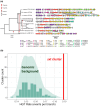Novel Toxin Biosynthetic Gene Cluster in Harmful Algal Bloom-Causing Heteroscytonema crispum: Insights into the Origins of Paralytic Shellfish Toxins
- PMID: 39545400
- PMCID: PMC11702299
- DOI: 10.1093/gbe/evae248
Novel Toxin Biosynthetic Gene Cluster in Harmful Algal Bloom-Causing Heteroscytonema crispum: Insights into the Origins of Paralytic Shellfish Toxins
Abstract
Caused by both eukaryotic dinoflagellates and prokaryotic cyanobacteria, harmful algal blooms are events of severe ecological, economic, and public health consequence, and their incidence has become more common of late. Despite coordinated research efforts to identify and characterize the genomes of harmful algal bloom-causing organisms, the genomic basis and evolutionary origins of paralytic shellfish toxins produced by harmful algal blooms remain at best incomplete. The paralytic shellfish toxin saxitoxin has an especially complex genomic architecture and enigmatic phylogenetic distribution, spanning dinoflagellates and multiple cyanobacterial genera. Using filtration and extraction techniques to target the desired cyanobacteria from nonaxenic culture, coupled with a combination of short- and long-read sequencing, we generated a reference-quality hybrid genome assembly for Heteroscytonema crispum UTEX LB 1556, a freshwater, paralytic shellfish toxin-producing cyanobacterium thought to have the largest known genome in its phylum. We report a complete, novel biosynthetic gene cluster for the paralytic shellfish toxin saxitoxin. Leveraging this biosynthetic gene cluster, we find support for the hypothesis that paralytic shellfish toxin production has appeared in divergent Cyanobacteria lineages through widespread and repeated horizontal gene transfer. This work demonstrates the utility of long-read sequencing and metagenomic assembly toward advancing our understanding of paralytic shellfish toxin biosynthetic gene cluster diversity and suggests a mechanism for the origin of paralytic shellfish toxin biosynthetic genes.
Keywords: biosynthetic gene cluster; cyanobacteria; horizontal gene transfer; saxitoxin; selection.
Published by Oxford University Press on behalf of Society for Molecular Biology and Evolution 2024.
Figures



Similar articles
-
Paralytic shellfish toxin biosynthesis in cyanobacteria and dinoflagellates: A molecular overview.J Proteomics. 2016 Mar 1;135:132-140. doi: 10.1016/j.jprot.2015.08.008. Epub 2015 Aug 25. J Proteomics. 2016. PMID: 26316331 Review.
-
Temperature-Driven Intraspecific Diversity in Paralytic Shellfish Toxin Profiles of the Dinoflagellate Alexandrium pacificum and Intragenic Variation in the Saxitoxin Biosynthetic Gene, sxtA4.Microb Ecol. 2025 Aug 8;88(1):87. doi: 10.1007/s00248-025-02586-1. Microb Ecol. 2025. PMID: 40779244 Free PMC article.
-
Evolution and distribution of saxitoxin biosynthesis in dinoflagellates.Mar Drugs. 2013 Aug 8;11(8):2814-28. doi: 10.3390/md11082814. Mar Drugs. 2013. PMID: 23966031 Free PMC article. Review.
-
Molecular and morphological survey of saxitoxin-producing cyanobacterium Dolichospermum circinale (Anabaena circinalis) isolated from geographically distinct regions of Australia.Toxicon. 2017 Nov;138:68-77. doi: 10.1016/j.toxicon.2017.08.006. Epub 2017 Aug 7. Toxicon. 2017. PMID: 28797629
-
Dataset of genome sequence, de novo assembly, and functional annotation of Ruegeria sp. (PBVC088), a marine bacterium associated with the toxin-producing harmful dinoflagellate, Pyrodinium bahamense var. compressum.Data Brief. 2022 Jan 28;41:107881. doi: 10.1016/j.dib.2022.107881. eCollection 2022 Apr. Data Brief. 2022. PMID: 35198665 Free PMC article.
Cited by
-
Saxitoxin: A Comprehensive Review of Its History, Structure, Toxicology, Biosynthesis, Detection, and Preventive Implications.Mar Drugs. 2025 Jul 2;23(7):277. doi: 10.3390/md23070277. Mar Drugs. 2025. PMID: 40710502 Free PMC article. Review.
References
-
- Akaike H. Information theory and an extension of the maximum likelihood principle. In: Petrov B, Csaki F, editors. International symposium on information theory. Budapest: Akademiai Kiado; 1973. p. 267–281.
-
- Anderson D. HABs in a changing world: a perspective on harmful algal blooms, their impacts, and research and management in a dynamic era of climactic and environmental change. In: Kim HG, Reguera B, Hallegraeff G, Lee CK, Han MS, Choi JK, editors. Harmful Algae 2012, Proceedings of the 15th International Conference on Harmful Algae. International Society for the Study of Harmful Algae; 2014. p. 3–25. - PMC - PubMed
MeSH terms
Substances
Grants and funding
LinkOut - more resources
Full Text Sources

